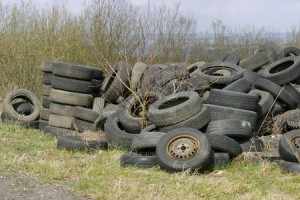
Replica of the Susan Constant
Imagine the Mid-Atlantic Coastal Plain during the spring of 1607. With sails billowing, the Susan Constant, piloted by Christopher Newport, cruised toward the future Jamestown. The surrounding forest understory was covered with native ferns, waxmyrtles, and winterberries. Flowering dogwoods, native redbuds and serviceberries were erupting with color, the luxuriant leaf litter was thick and abundant, the topsoil was rich and fertile. Native oaks and hickories protected the understory from the harsh effects of driving rains, limiting the amount of silt that could cloud the shallow, productive estuary we now call the Chesapeake Bay.
Perhaps a sufficiently motivated super-squirrel could have traversed the expansive coastal plain, never leaving the canopy. Had our imaginary super-squirrel descended to the forest floor, never would she have been forced to hide acorns among shredded, steel-belted, petroleum-based used tires.
Rubber Mulch Leaches Heavy Metals
Had modern used tires covered the 17th century forest floor, today’s Chesapeake Bay may well be a dead zone. Drinking local well water could lead to zinc poisoning. Used tires and the subsequent byproduct, crumb rubber, have been demonstrated to leach heavy metals and cause zinc toxicities in plants and to disrupt entire aquatic ecosystems. According to Dr. Linda Chalker-Scott, “It is abundantly clear from the scientific literature that rubber should not be used as a landscape amendment or mulch.”
Our automobile dependent culture generates enormous quantities of used tires, almost one annually for every American. Tire disposal continues to be an environmental headache for the tire industry and our nation.
Industry’s Indecent Solution

The United States generates approximately
300 million used tires annually.
Rubber industry executives have managed to marry industry funded studies with a glitzy marketing campaign. They have convinced some portion of the public to buy this toxic waste and spread it across our landscape. Less industry expense, more industry profit. Except their P&L statements don’t include the losses incurred by the environmental degradation. That price will be paid by the future inhabitants of our poisoned landscapes, human and non-human alike.
I’ve reviewed the shiny UV-coated packaging that contains crumb rubber. Some claims are equivocal at best. One package claims the rubber mulch is non-toxic. Non-toxic to who? Under what conditions? Under what time frames? It has certainly been proven to cause zinc toxicities in plants. Labeling rubber mulch non-toxic because you can hold it in your hands at room temperature does not reveal the whole truth.
Rubber mulch is advertised as a permanent mulch. It may last longer than wood mulch, but it is certainly not permanent. Microbes will eventually break down the rubber compounds and release the toxic heavy metals into the surrounding soil. Poisoning the soil ten years from now, or a hundred years from now is still poisoning the soil.
Don’t Use Rubber Mulch
Nature devised a wonderful strategy for recycling, fertilizing, and maintaining a healthy ecosystem. Let’s mimic mother nature and add organic mulches over our trees and shrubs. Use your local leaf litter, grind it up if necessary and recycle the nutrients in an environmentally friendly fashion. Alternatively, have us deliver free wood chips or purchase natural mulches that have been produced responsibly.
Good organic mulches improve soil structure and fertility. They insulate roots from temperature extremes. They protect the soil from hard, driving rains, and allow water to be absorbed more slowly. Mulching properly is one of the best cultural practices you can perform to improve the health of your landscape. Relabeling ground up toxic waste as mulch is marketing misinformation concocted only for the benefit of the tire industry and for the profit of rubber barons.
Disposing of tire waste responsibly is an important problem that continues to need innovative solutions. If we choose to spread crumb rubber across our landscapes, I predict it will become an environmental disaster. One only has to look at the ill-fated “tire-reef” fiasco off the coast of Florida over four decades ago to realize how poor judgement concerning toxic tire disposal is not a mistake our culture needs to repeat.
Use organic mulch, 2 – 4 inches deep and your soil, shrubs, and trees will reward you with an ecologically sound, aesthetically splendid landscape.
